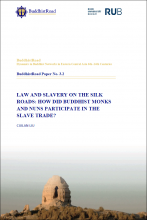BuddhistRoad Paper 3.2 "Law and Slavery on the Silk Roads: How did Buddhist Monks and Nuns Participate in the Slave Trade?”
Synopsis
The selling and buying of human beings as slaves were highly sensitive, controversial, and profitable businesses on the trading networks along the Silk Road. Manuscripts excavated from Cave 17 in Dunhuang (敦煌) and tombs in the Astana graveyard in Turfan contain records documenting how Buddhist institutions and individual monks and nuns were involved in the slave trade as buyers, owners, sellers, and transaction witnesses between the 7th and 10th centuries. Examining lawsuits over slave ownership related to monks and nuns, this article explores the roles Buddhists played in the slave trade along the Silk Roads, and the legal implications of such involvement. It reveals that despite disapproval of slave ownership in Buddhist canon law and strict legal regulations on slave trade in the Tang Dynasty (618–907, 唐), Buddhist monks and nuns showed little concern over these restrictions when participating in the trading of slaves in the local markets in Dunhuang and Turfan. Whenever others challenged their possessions of slaves, these monks and nuns showed no reluctance in seeking legal intervention in the state court. In these practices, such Buddhist monks and nuns received evident support from the lay legal system. On one occasion, the local government ruled in favor of a Buddhist nun to protect her rights as the adoptive mother whilst ignoring her enslavement of a free commoner’s daughter, a severe crime against Tang law.
Chinese Translation
在丝绸之路上, 把人口当成奴隶来交易是一个既敏感, 充满争议, 又非常有利可图的生意. 敦煌17窟和吐鲁番阿斯塔纳墓地中出土的文书记录了佛教寺院和僧尼个人作为买方, 持有者, 卖方, 和交易见证人等身份卷入到七到十世纪的丝绸之路上的奴隶交易过程中. 本文通过对一系例涉及僧尼的奴隶归属法律案件的研究来探讨佛教徒在丝绸之路上的这些奴隶交易中所承担的角色以及其所牵涉的法律问题. 本文显示虽然佛教戒律不认可持有奴隶, 唐代的法律也对奴隶交易有严格的规定, 敦煌和吐鲁番地区的佛教僧尼在参与当地市场的奴隶交易时似乎对这些禁令很少在意. 当别人质疑他们所占有的奴隶的时候, 这些僧尼毫不犹豫地去地方法庭寻求法律干预. 他们的这些举动得到了世俗法律体系的明显支持. 在一个案例中, 地方法庭甚至做出了对一个比丘尼有利的判决. 这个判决一方面维护了她作为养母的权利, 令一方面却忽视了她把一个良民的女儿当作奴隶来用的这一严重违反唐代法律的行为.

Downloads
Published
Categories
License

This work is licensed under a Creative Commons Attribution-NonCommercial-NoDerivatives 4.0 International License.

